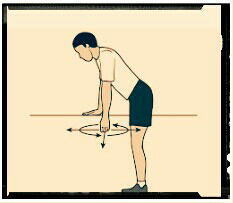IMPINGEMENT SYNDROME
It is also called as supraspinatus Tendinitis or painful arc syndrome.
"Impingement syndrome is a clinical syndrome occurs due to narrowing of the subacromion space which cause impingement of tendons of rotator cuff muscles under the subacromion bursa causing pain and restriction of movements."
-The subacromion space is a space between humeral head and coracoacromial arch .Average value is 10 mm. When this space decrease due to any cause it causes impingement of rotator cuff tendons.
The muscles of rotator cuff includes supraspinatus ,Infraspinatus, subscapularis and Teres minor muscles.
ETIOLOGY:-
1)Occurs due to chronic and repetitive compression of rotator cuff tendons.
2) It most commonly occurs in overhead athletes as in swimmers, ballers, weight lifter etc.
3)It can also be caused by an injury to shoulder joint .
4) It may occurs due fracture of greater tuberocity.
PATHOGENESIS:-
-Chronic repetitive overhead activities.
-Narrowing of subacromion space.
-Cause compression of rotator cuff tendons .
-Cause Rotator cuff dysfunction.
-As a result appearance of symptoms like pain and restriction of movements.
STAGES OF IMPINGEMENT SYNDROME :-
1) STAGE -1:- Inflammation .
2)STAGE-2:-Tendinitis and Fibrosis.
3) STAGE -3:-Bone spure and tendon rupture.
CLINICAL PRESENTATION :-
1) Shoulder pain.
2)Tenderness below Acromion and greater tuberocity .
3)Pain and weaknesses with active Abduction in midrange (60°-120°).
4)Pain during active resisted internal rotation .
5) Tenderness over subacromion area.
SPECIAL TESTS :-
1) Neer impingement test:-
-Patient stands or sits comfortably.
2)Howkin's test:--The athlete stands or sits with arm and elbow each flexed to 90°and arm internally rotated.
- The clinician applies overpressure to internal rotation produces symptoms of anterior shoulder pain.
-Produce symptoms indicates positive test for impingement syndrome.
INVESTIGATION :-
1) X-Ray
2)USG
3)MRI
TREATMENT :-
1)Conservative treatment :-
-NSAIDS
-Local injection of hydrocortisone.
-Local injection of steroids.
2)Surgical treatment :-
-In case of failure of conservative management for 3 months.
-The following surgeries are performed :-
1) Excision of adhesion.
2)Manipulation of shoulder .
3)Excision of calcium deposits.
4)Repair of incomplete tear .
5) Acromioplasty.
6)Acromioctomy.
7)Direct suture for complete tear .
8)Flaps , grafts may also be used.
PHYSIOTHERAPY MANAGEMENT :-
GOALS :-
1) Pain relief .
2 )Prevent the condition from further worsening.
3 )Muscle strengthening .
4)Functional improvement.
TREATMENT :-
1) Thermotherapy :-TENS ,US ,SWD.
2)Passive mobilization :-Relaxed full range passive mobilisation.
3)Pendular exercises.
4)Shoulder ladder exercises.
5)Gradual resisted exercises.
Physiotherapy management after surgery:'
1) shoulder immobilisation for 3 weeks.
2) Active elbow , wrist and hand movement should be encouraged after surgery.
PENDULAR EXERCISES
- Get link
- X
- Other Apps





Comments
Post a Comment
Please don't enter any spam link